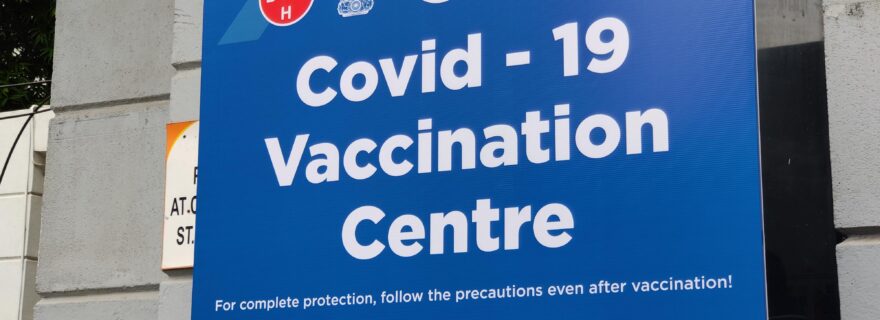A digital platform-driven COVID-19 vaccine drive amidst a digital divide: Lessons from India
What challenges did the Government of India face while attempting to conduct a digital platform-driven COVID-19 vaccine drive amidst India’s mass digital divide?
CoWIN-driven COVID-19 vaccination drive in India
One of the defining factors of the 2020s era has been the COVID-19 pandemic caused by the novel SARS-CoV-2 virus. It has crippled healthcare systems and economies since March 2020, with hardly any phase of respite. Since January 2021, people the world over have been getting vaccinated at differing rates against the COVID-19 virus. Governments across the globe have been relying on digital health solutions to orchestrate COVID-19 vaccination programmes in their countries. This is because we live in a digital age, where there is increasing reliance on digital technologies to deliver public services. In such a scenario, digital health solutions can prove to be key in the orchestration of a mass vaccination programme. Consequently, most countries have scaled up their already existing digital tools, or developed new, more specific ones as a part of their response to the pandemic.
The Indian Government too came up with a new digital platform, Covid Vaccine Intelligence Network (CoWIN), to orchestrate its national COVID-19 vaccination drive. The Prime Minister of India rolled out CoWIN on 16 January 2021. It was opened and rolled out in phases for different categories of people, primarily based on age group distinction. Initially, registration for vaccination was available mandatorily online through CoWIN. Provisions for offline registrations were incorporated gradually over six months post-launch.
The requirement of mandatory registration on CoWIN in the initial phase brought to light the existing ‘digital divide’ in India. As the 2nd COVID-19 wave gripped the nation creating urgency to take the vaccine shot, the ‘digitally smart’ class of people was seen getting the vaccine shots earlier than those who suffered from ‘digital exclusion’. It resulted in an apparent delay of varying periods, in vaccination of the digitally disadvantaged segments of the population. Hence, the biggest challenge in the path of even and equitable use of CoWIN in driving the COVID vaccination is seen to be the digital divide that exists in India.
Existing digital divide in India
The Organisation for Economic Co-operation & Development (OECD) defines ‘digital divide’ as:
‘Gap between individuals, households, businesses, and geographic areas at different socio-economic levels about both their opportunities to access information and communication technologies (“ICTs”) and to their use of the Internet for a wide variety of activities.’
India’s digital divide leaves disadvantaged segments of society much more vulnerable to inequality and discrimination in getting early vaccination and accessing public places and services. The digital divide in India is mostly rooted in its basic socio-economic character and level of regional development. Factors such as urban-rural divide, remoteness of habitations, socioeconomic status, literacy rate; especially the digital literacy status, availability of smart health care infrastructure, availability, and affordability of digital gadgets like smartphones, wireless access, and wireless data subscription, etc. play crucial roles in creating digital capability and the digital divide.
When relying on a digital health solution for a mass vaccination programme, it must be evenly and easily accessible to all, irrespective of one’s gender, race, income, literacy, geographical location, place of birth, or socio-economic status – without any discrimination, disadvantage or partiality – to ‘fully’ achieve its objectives. This essentially requires extensive access to mobile phones and the internet, and an enabling level of digital literacy and capacity to use new tools. Similarly, a technologically robust architecture of e-health and connectivity is a necessity to realise the goals of digital health tools; equally accessible and non-discriminatory.
Lessons from India for the future
In a situation of a significant digital divide such as that of India, no vaccination policy can successfully exclusively rely on a digital portal to meet its target of universal immunisation. It must have sufficient ‘non-digital options’ and complementary measures in place from the initial phases of a digital platform-driven vaccination drive itself. This is to help ensure that every citizen gets easy and equal access to vaccines. For future mass vaccination drives, the Indian Government ought to keep the digital divide in India in mind while formulating its vaccination policy.
It is noteworthy that there have been successful physical vaccination drives conducted in India before, and in formulating its COVID-19 vaccination policy. The Indian Government did introduce aspects such as door-to-door vaccinations by healthcare workers gradually in the COVID-19 vaccination drive. However, it could have also relied on the aspects of these previous vaccination drives to incorporate physical vaccination registration for the digitally disadvantaged in its COVID-19 vaccination policy from the initial phase itself.
The real measure of inclusivity of a digital platform lies in its ability to onboard the excluded ones by offering them the option to gain access to the platform riding on offline infrastructure and non-digital options that help eliminate the exclusion.
Hence, it is essential that in the future, the Indian Government takes a rights-based approach when relying on digital technologies for public delivery services. This will help ensure that the principles of equality and non-discrimination are upheld while orchestrating a mass vaccination campaign. Lastly, the digital tools ought to have a responsive grievance-redressal and feedback mechanism for the citizens to register their difficulties and grievances with the concerned authorities and get quick responses and redressal.



0 Comments
Add a comment